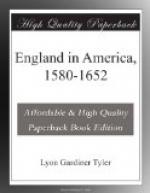As the patent under which they sailed had no force in the territory of the Plymouth Company, they united themselves by the so-called “Mayflower compact,” November 11, 1620, into a “civill body politic,” and promised “submission and obedience to all such ordinances as the general good of the colony might require from time to time.” Under the patent John Carver had been chosen governor, and he was now confirmed in that office under the new authority, which followed pretty nearly the terms of the old.[16]
For five weeks they stayed in the ship, while Captain Miles Standish with a small company explored the country. In the third expedition, after an attack from the Indians and much suffering from snow and sleet, Standish’s men reached a landing nearly opposite to the point of Cape Cod, which they sounded and “found fit for shipping.” There “divers cornfields” and an excellent stream of fresh water encouraged settlement, and they landed, December 11 (Old Style), 1620, near a large bowlder, since known as Plymouth Rock.
By the end of the week the Mayflower had brought over her company of emigrants—seventy-three males and twenty-nine females—and December 25, 1620, they began to erect the first house “for the common use to receive them and their goods.” The Indian name of the place was Patuxet, but the emigrants called it New Plymouth “after Plymouth, in old England, the last town they left in their native country";[17] and it was a curious coincidence that the spot had already received from John Smith the name of Plymouth. Later the town was called simply Plymouth, while the colony took the name of New Plymouth.
[Footnote 1: Smith, Works (Arber’s ed.), 699; Bradford, Plimoth Plantation, 117.]
[Footnote 2: Smith, Works (Arber’s ed.), 699-701, 731-742, 745.]
[Footnote 3: Gorges, Description of New England (Mass. Hist. Soc., Collections, 3d series, VI.), 57.]
[Footnote 4: Poore, Charters and Constitutions, I., 921. ]
[Footnote 5: Cf. Cheyney, European Background of Am. Hist., chap. xi.]
[Footnote 6: Neal, Puritans, I., 149-151, 202; cf. Cheyney, European Background of Am. Hist., chap. xii.]
[Footnote 7: Neal, Puritans, I., 232; Hart, Source-Book, No. 15.]
[Footnote 8: Bradford, Plimoth Plantation, 13.]
[Footnote 9: Hunter, Founders of New Plymouth.]
[Footnote 10: Bradford, Plimoth Plantation, 15-29.]
[Footnote 11: Ibid., 27.]
[Footnote 12: Bradford, Plimoth Plantation, 28, 488-493; Mather, Magnolia, I., 113.]
[Footnote 13: Bradford, Plimoth Plantation, 29-38.]
[Footnote 14: Brown, First Republic, 424.]
[Footnote 15: Smith, Works (Arber’s ed.), 783; Bradford, Plimoth Plantation, 56-58.]




